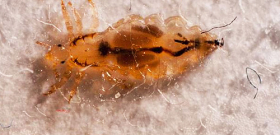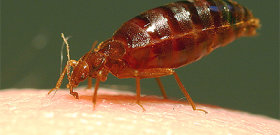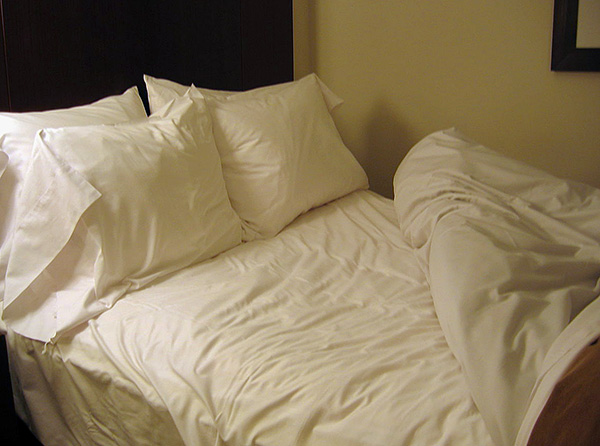
The linen mite is in most cases the common name for dust mites, small synanthropic arthropods that live in most apartments and houses around the world. They do not bite people like ixodid ticks or bedbugs, but feed only on exfoliating particles of human and domestic animal skin, that is, they do not directly harm people.
However, dust mites cause severe allergic reactions and chronic respiratory diseases, including bronchial asthma. They are called underwear by mistake due to the fact that very often they multiply en masse in bed and under bedding, where dandruff accumulates from the head and grains of skin from the body. For the same reason, they are sometimes called bed mites, which is also not entirely correct.
Less commonly, the following insects are called linen mites:
- Linen louse, which settles in the seams and folds of underwear and causes serious inconvenience with constant bites, accompanied by severe itching;
- Bed bugs, which are sometimes called linen bugs due to the fact that they are often found on bed linen.
All these unwanted neighbors of a person are quite different from each other. For example, the photo below shows house dust mites in a carpet at high magnification:

And this is what bed bugs look like (adults and larvae):
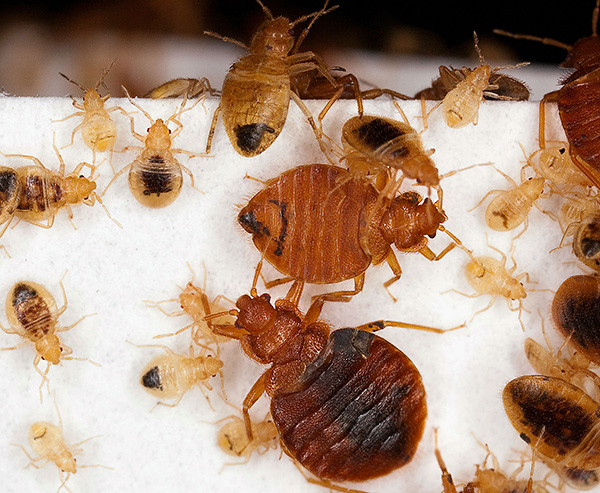
The following photo shows what linen lice look like on clothes:

In addition to obvious differences in the shape and color of the body, these creatures differ significantly from each other in size: they all belong to different "weight categories" (dust mites are only 0.2-0.3 mm in size, and bugs are larger by about 10-15 once). In addition, all these arthropods lead a different lifestyle, are to a different extent associated with humans, and therefore not only harm differently, but are also removed from the premises in different ways.
Dust mites in pillows and bedding
dust mites - These are microscopically small synanthropic arthropods of the arachnid class, the main habitat of which is human habitation. They got their name because they are found in the greatest quantities in dust accumulations, where their main food is located - skin flakes that exfoliate people from the feet, hands, head and other parts of the body.

The amount of dry skin that one person loses during the day is enough to feed several thousand mites, and therefore, under suitable home conditions, these pests multiply very quickly in an apartment.
It is interesting
Dry crumbling human skin is the main, but not the only food for dust mites. As an additive to the diet, they can eat molds, albeit not of all types that can grow in an apartment. However, in the absence of people or pets, mites cannot live in a room, even if a large amount of mold appears here.
Dust mites are very small (of the "linen mites" considered, these are the smallest representatives). An adult individual reaches a length of 0.2-0.3 mm, and having a translucent body, it is hardly noticeable even against a dark background.However, if you look closely, ticks can be seen in large clusters even with the naked eye: they look like tiny whitish dots.
The photo below shows dust mites in a carpet:
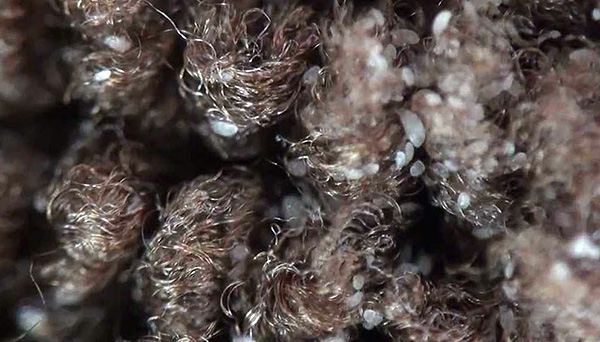
It is quite difficult to see dust mites on white bed linen - it is better to inspect dust accumulations under the bed.
Dust mite eggs, nymphs of different ages, cuticle residues after molting, as well as excrement are even smaller in size, and it will not work to examine them in detail with the naked eye, without a magnifying glass and a microscope.
These pests can live indoors in almost any place in which new remnants of human skin accumulate and regularly appear. These can be corners of rooms, spaces under tables, gaps between mattresses and the bed frame, folds and joints of soft parts of sofas, pillows and blankets, the fabric of which has large enough pores so that both skin scales and the mites themselves fall into them. It can also be gaps between parquet boards, behind skirting boards and under furniture, pile of carpets and carpet paths.
The less often the room is cleaned and the more dust accumulates here, the more likely the appearance and mass reproduction of dust mites here.
On a note
Studies by acarologists show that signs of the presence of dust mites are found in all apartments and houses without exception. These creatures are easily brought into the house on shoes, with things, with dust, sometimes even with the wind from the windows. Whether they breed here or not will depend only on how favorable the conditions in the room are (humidity, amount of food, temperature, frequency of regular cleaning).
Dust mites do not bite a person and do not suck his blood.The main harm they cause is the excretion of a certain amount of specific digestive enzymes with their excrement. These enzymes are biochemically very active, they ensure the normal digestion of food that is generally difficult to digest - the dry remains of human skin. And due to the high chemical activity, these enzymes can cause pronounced allergic reactionsif they enter the human respiratory tract with dust.
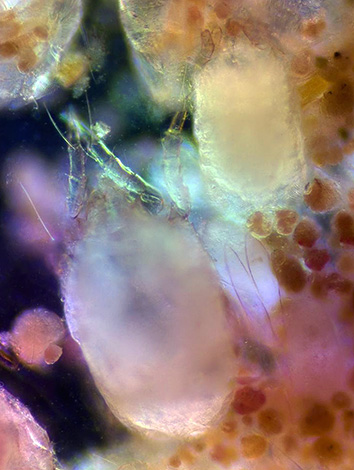
Since the excrement of ticks themselves is very small and has a diameter of only hundredths of a millimeter (and after drying it also crumbles into smaller pieces), they very easily rise into the air, after which they are inhaled by a person (especially if these “linen mites” left them on the pillow or sheets).
See also article about dust mites in pillows.
To a lesser extent, allergies are caused by the remnants of the covers of the bodies of ticks, which decompose in different places of the apartment after the death of these creatures.
Studies show that up to half of the cases of chronic rhinitis worldwide are associated with allergies to excrement and dust mite remnants. If a person constantly and for no apparent reason stuffs up his nose, regularly has a runny nose at night, then with a high probability dust mites can be the cause. In many cases, such chronic rhinitis develops in people into bronchial asthma. According to the results of the same studies, it is dust mite excrement in homes that is the most common cause of bronchial asthma in the world.
It is clear that the most dangerous is the accumulation of ticks on bedding (especially in pillows).Here it is easiest for a person to inhale either the remains of excrement, or the ticks themselves, but here they are the least noticeable, and if they settle under linen, on a mattress or in the folds of a sofa, they are quite well protected from destruction - sofas and mattresses are rarely washed and cleaned, and such unwanted neighbors literally thrive here.
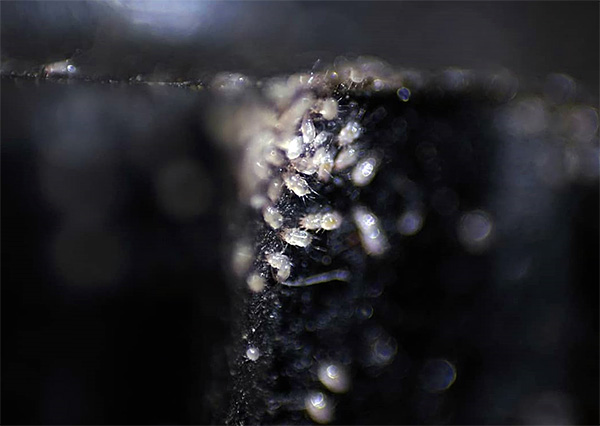
A logical question arises: how do you know if there are dust mites in the apartment? And how to detect them at home, for example, directly on the bed, if they are very small and merge in color with the mattress or sheet itself?
For this, there are special test systems that work on a principle similar to the principle of operation of pregnancy tests. Water is poured into a special container and dust collected in one place or another in the room is poured. Then an indicator paper is lowered into the container, which, in the presence of tick antigens, takes on a certain color. By comparing this color with the color on the scale, you can find out if there are mite antigens in the dust sample, that is, whether these pests live in the place where the dust was taken from.
You can also look at dust samples under a microscope, but such a search will be more laborious.
linen louse
linen lice are human blood-sucking ectoparasites. They settle in clothes, in underwear, in the folds and seams of the fabric, from where they crawl several times a day onto the human body, bite it and suck blood, and then return to the clothes again. It is these parasites that are most often mistaken for the "linen tick", which leaves bites on the skin.
The photo below shows the bite marks of these insects:

And in this picture - the louse itself with a significant increase:
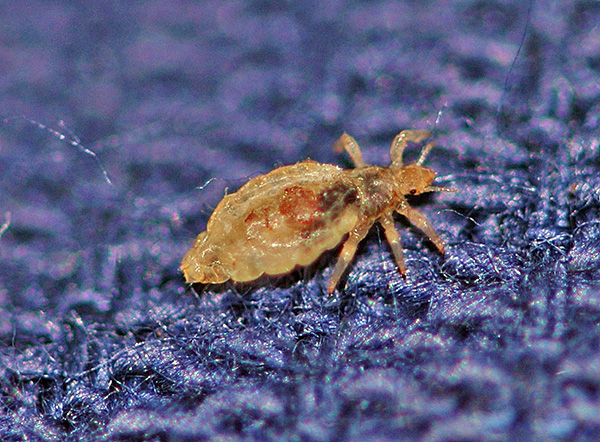
A more strict and scientifically accepted name for this insect is the body louse. It more specifically indicates that these insects settle in clothes, and not in bedding, since only on clothes do they have almost constant access to the human body - a source of food.
In everyday life, completely different versions of the names of these insects can be found - from "clothing" to "rag".
It is interesting
It is believed that the body louse is a species that has formed only due to the neighborhood with a person. Scientists believe that its ancestor is head louse, constantly living on the scalp. Over the many thousands of years during which people have been using clothes, some lice have adapted to life in clothes, developed anatomical features that make it possible to feel safer here (for example, a certain shape of the paws), and have moved so far away from the original form that in currently under normal conditions do not interbreed. In the laboratory, the offspring obtained from hybrids of body lice and head lice are quite prolific, which indicates their very close relationship.
Many researchers even believe that the body louse is not a separate species, but only a morphotype of the head louse, which only with time in the future will be able to acquire such pronounced differences that it can be recognized as an independent taxonomic unit. If this hypothesis is correct, then it was the people and their clothes that created the clothes louse as it is. If people didn’t wear clothes, such a view would not appear in principle.
Linen lice most often settle on the clothes of those people who do not follow the basic rules of hygiene. If you wash the linen at least once a week and have 2-3 shifts so that the same set is in the closet for at least a week, then the lice simply cannot live here. These insects die in water, and even if by some miracle they survive washing, they will then die of hunger, because they cannot go without food for more than 3 days.
Therefore, to live, develop and multiply they can only on underwear that a person wears for months without a change and without washing.
On a note
A louse found on a bed is a rarity. As a rule, an insect that has fallen from clothes or from the head will almost certainly die, because due to its inability to move quickly, it is unlikely to be able to climb onto a person again.
Obviously, in this case, such “linen mites” are most often the problem of people leading an asocial lifestyle: the homeless, vagrants, refugees, as well as those imprisoned in third world countries.

People who take care of their clothes and follow the rules of hygiene are very rarely bothered by these parasites. Even children who are not particularly prone to order, but controlled by their parents, are usually not touched by linen lice.
Linen lice bites not painful, but cause itching, sometimes quite strong. Reddish spots remain at the bite sites, but the skin punctures themselves, and even more so, blisters usually do not appear. Only people with high skin sensitivity or allergies can develop more severe symptoms - swelling, a rash around bite sites, and sometimes even a fever.
In areas with a poor epidemiological situation, body lice can carry typhus and some other life-threatening infectious diseases. A person who becomes ill after bites without timely treatment may die.However, both typhus and other lice-borne diseases are relatively rare today, especially in the civilized world.
Lice are highly visible, albeit small, insects. The body length of an adult is 3-4 mm, that is, it is quite possible to consider it without additional devices. And if the louse is fed, and there is a drop of blood in its abdomen, then the parasite becomes even more noticeable.
The photo below shows an adult linen louse (unlike ticks, it has 6 legs, not 8):

In addition to lice, you can find their eggs on clothes - nits, which are securely glued by females to the fibers of the fabric or to the pile. They look just like nits on human hair:

The most important feature of linen lice is that they cannot live anywhere except in clothes. They do not settle in beds or sofas, they cannot live in dust or hair, which is how they differ from other arthropods, which are sometimes called linen mites.
Bed bugs
bed bugs sometimes they are called mites simply by mistake - they stick to the skin and suck blood like forest mites, and these parasites can indeed often be found on bed linen.
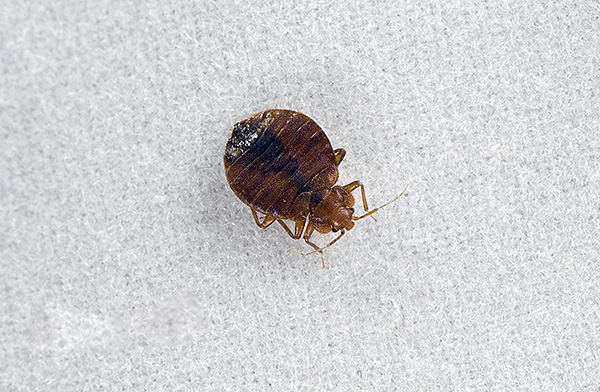
At the same time, bed bugs have little in common with true mites. For comparison:
- A bed bug bites many times in one sortie, sucks blood for a short time, and after a quick saturation hides in a shelter. ixodid tick but bites only once, and after sucking, sucks blood for several days, and only then unhooks;
- Bedbugs have 6 legs, while ticks have 8;
- Bedbugs live only in human housing (with rare exceptions - for example, they sometimes live in caves where bats live), and ixodid ticks live in the wild.
Habitats of bed bugs in the apartment can be very different. Bedbugs hide in sofas, beds, under the upholstery of upholstered furniture, under outgoing wallpaper, behind baseboards, under cabinets, they are found in electrical outlets, household appliances, and flower pots. Here you can find the so-called "nests", where a large number of insects gather, accumulate eggs, chitinous covers, excrement.
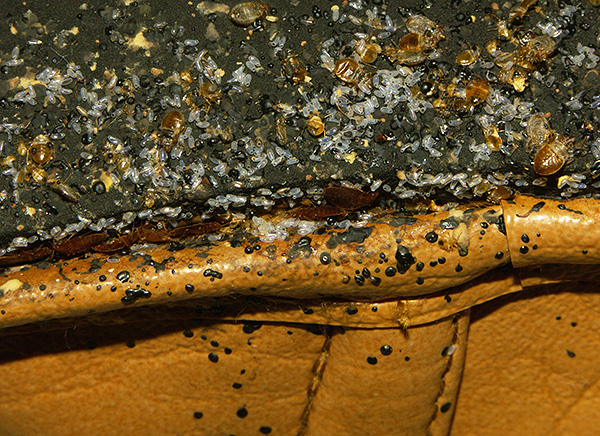
At the same time, bed bugs rarely settle in linen and clothes. By chance, the parasite may be here, but if a person put on such clothes, the insect will try to retreat as quickly as possible so as not to be at risk of being detected and killed.
Thus, in any case, the term "linen mite" is erroneous. How to understand what kind of parasite or pest was found at home and what can be done to reliably get rid of it - let's figure it out ...
We identify the parasite at home
So, if there are no insects in the house, but at least one person constantly experiences unreasonable nasal congestion, especially if it is chronic and intensifies at night, then dust mites can be suspected in the apartment. To make sure that they are here, it is enough to buy a test system and analyze the dust collected under the bedding, near the baseboards and under the bed. If the result is positive, then it will be necessary to deal with dust mites.
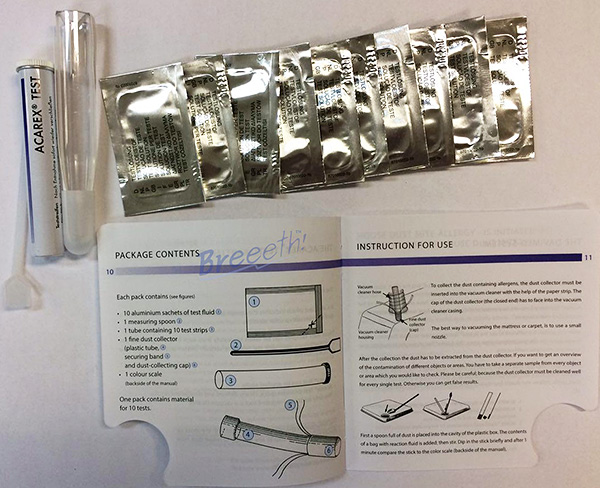
If a blood-sucking insect is found, it can be identified at home as follows:
- If the parasite is found on clothes or on the body, and it cannot escape quickly, has light yellow integuments of the body and is 2-3 mm long, then it is most likely a body louse. For reliability, it is worth examining the clothes - if other similar parasites come across here, these are definitely lice;
- If the insect is found on the bed or on the floor in the bedroom, has a body length of 3-5 mm, runs fast enough, and leaves blood stains when crushed, this is a bed bug. In this case, you need to inspect the sofa and bed, remove the lining, examine all the cracks and folds of the fabric - if other brothers are found here, black dots (bug excrement), white eggs, then these are definitely bed bugs.
In itself, the presence or absence of bites is not an unambiguous diagnostic sign, since a certain number of people practically do not feel any bedbug bites, nor lice bites, and no obvious signs of parasite attacks are found on their bodies (because of this, by the way, there is even a widespread misconception that bed bugs do not bite everyone in the apartment, but only certain people).
On a note
An important nuance: lice can bite all day long while a person is wearing infected underwear, and bedbugs bite mainly at night when a person is sleeping.
Sometimes other parasites can be found in underwear. For example, after a walk in the woods, an ixodid tick may be found under your underwear, and on the bed after sleep you can see fleas that have moved here from pets. But hardly anyone would call them linen mites.
Destruction of dust mites
Getting rid of dust mites in an apartment, despite their microscopic size, is relatively easy even on your own, without calling exterminators and without special equipment.If you regularly carry out thorough wet cleaning in the room, diligently shake out carpets, runners, mattresses and blankets, wash bed linen, then with these relatively simple measures it will be possible to destroy most of the pest population in just 2-3 weeks.

If you continue to maintain a strict cleaning schedule, then the mites will gradually practically disappear, since most of the food for them will be removed from the premises, and the surviving pests themselves will be regularly eliminated with each subsequent cleaning.
More radical methods of struggle:
- Cleaning floors, carpets, beds, baseboards with special vacuum cleaners from dust mites. An example of such devices is the Philips FC6230/02 Mite Cleaner vacuum cleaner, which is convenient for cleaning beds, pillows, and upholstered furniture. Allows you to get rid of dust mites in a short time;
- Treatment of the premises with chemical acaricides is a laborious process, to some extent associated with the risk of poisoning the person himself. This method is very effective, although in most cases it is not necessary;
- Thermal extermination of dust mites - treatment of their habitats with hot steam from a steam generator, removal of sofas and mattresses in the winter to frost, heating pillows and bed linen in the sun.
For additional interesting nuances, see also a separate article on this topic: How to get rid of dust mites in the apartment.
On a note
It is also believed that quartzing helps against dust mites.By itself, ultraviolet radiation is not particularly terrible for them (considering that they hide, including in places well protected from light), but the ozone formed when air is irradiated with ultraviolet rays from a quartz lamp is dangerous for dust mites in the same way as for any other animal. However, there is no unequivocal data on the possibility of rapid extermination of dust mites with quartz treatment.
These methods allow you to quickly and effectively destroy house dust mites, but in general they can be considered redundant. If you poison pests once and forget about regular cleaning again, then in a few months dust mites will still appear and multiply in the house. If cleaning is carried out regularly, then the population of ticks will decrease to non-dangerous values even without such drastic measures.
Effective measures to combat linen lice
Given the specifics of the lifestyle of linen lice, you need to deal with them a little differently than with dust mites. First of all, all clothes should be washed at the maximum temperature, especially underwear, and not only what is worn by a person, but also what is stored in closets. Before washing, things can be treated with special aerosols, for example, A-Par.
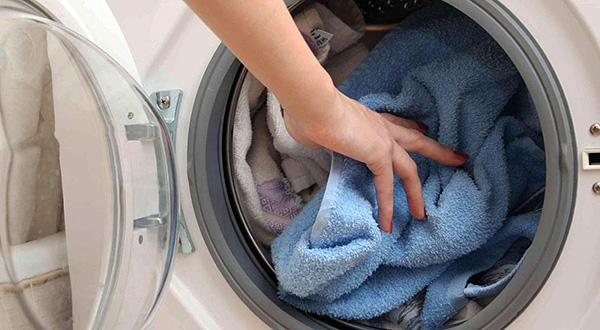
On a note
You can also freeze clothes outside in the winter or bake them in the car, left in the sun in the summer.
Secondly, you need to pickle the lice on the body and in the hair. With a certain probability, a person who allowed the reproduction of body lice can also be infected with head and pubic lice. To combat them, a variety of pediculicides are used, widely represented in pharmacies:
- Lice sprays (Pediculen-Ultra, Para-Plus, Paranit, Nyuda);
- Shampoos (Parasidosis, Pedilin, Chigia);
- Creams (Nix, Nittifor);
- crests, allowing combing out lice and nits without treating hair with chemicals;
- Ointments that allow you to be treated for pubic pediculosis (mainly based on benzyl benzoate).
Folk remedies - kerosene, turpentine, alcohol, vinegar - it is better not to use, because if mishandled they can be dangerous and cause severe chemical burns to the skin.
For maximum reliability, you should also wash all bedding - sheets, pillow cases, duvet covers.
For more tips on getting rid of linen lice, read this article.
If all these procedures are carried out carefully, then lice and nits will not remain on the linen and on the body.
Bed bugs
Bed bugs are the hardest to deal with. This is primarily due to the fact that they can hide indoors in almost any place, even in those where people are not aware of the presence of parasites.
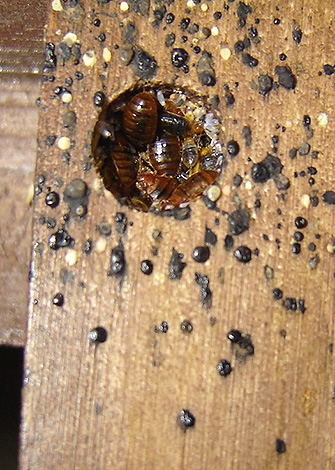
Secondly, bed bugs are hard to get rid of. thermal and mechanical methods - it is difficult to freeze the entire apartment without the risk of damaging communications, and heating the room to high temperatures can only be done using specialized equipment (moreover, this procedure is long and involves the risk of deformation of plastic interior elements from high temperature). It is also impossible to mechanically transfer or vacuum all the parasites with a strong contamination of the room.
You can quickly and effectively destroy bedbugs with the help of insecticides. By such means, all places where bedbugs can hide and where they can move are processed.Sometimes you have to disassemble the sofas, rip off the baseboards and lift the parquet. If this is not done, then some of the parasites will survive, and the persecution, if it gives any result, is only temporary.
For more information about the destruction of bedbugs in an apartment, see a separate article on this topic: Getting rid of bed bugs in the apartment quickly and effectively.
Also, do not forget about preventive measures, because if all the neighbors have bedbugs, then over time the parasites can again enter the apartment.
Illustrative video: dust mites crawl in a pillow ...

